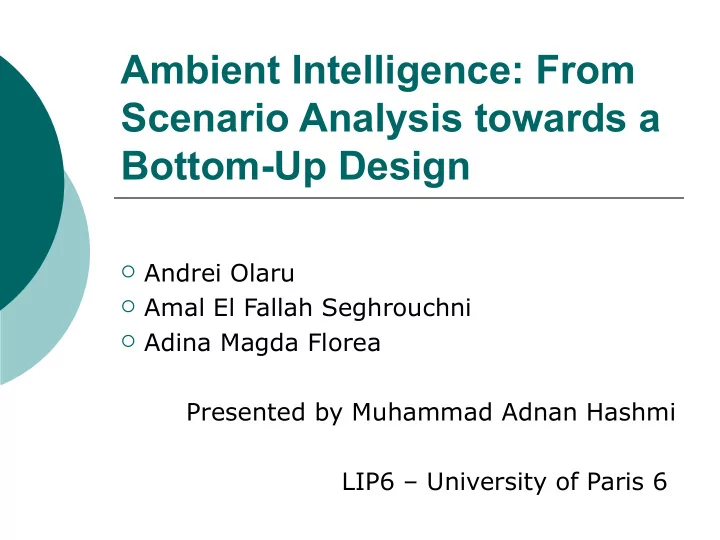

Ambient Intelligence: From Scenario Analysis towards a Bottom-Up Design Andrei Olaru Amal El Fallah Seghrouchni Adina Magda Florea Presented by Muhammad Adnan Hashmi LIP6 – University of Paris 6
Plan Introduction Ambient Intelligence Features of Ambient Intelligence Analysis of Existing Scenarios New Scenarios Rock Concert Scenario Medical Emergency Scenario Modeling of AmI Conclusion
What is Ambient Intelligence? A distributed, ubiquitous electronic / computational environment Supports people in their daily lives / activities Is a distributed, intelligent system
Layers of Ambient Intelligence Devices Personal and light Integrated with different capabilities Offer advanced interfaces Allow localization and other advanced types of sensing Network Pervasive Different types of communication Software Different programs to be integrated Application / Intelligent layer Moves information around in an intelligent manner Delivers relevant information to users Interface Allows gestures, speech Does not need previous training
Existing scenarios & their features Weiser: Speech recognition, Ubiquitous connections, Localization, Relevant information mining ISTAG: Interoperability of resources, Application of preferences, Network connection switching, Natural interaction Others: Suggestion systems, Seamless transfer of network services and connections, Location-based services Problems: From the point of view of a single agent Few details about the system working in background
Essential Features At the application layer Intelligence and robustness Decentralized solution, capable of working at the local level Simple, predictable, but generic and adaptive Based on context-awareness and associations The use of software agents as building blocks for the application layer Our proposal 2 new scenarios Building a system based on scenarios
The Rock Concert Scenario A large number of people and devices, with reduced centralized connectivity Information management by device- bound software agents Sharing of information: Locally by means of associations and compatibility of their contexts / preferences Is prioritized in function of the importance of information
The Medical Assistance Scenario Also using agents, but the flow of information is different due to the user’s preferences 2 agents, one for each user involved Agents receive information from smart interfaces Agents use communication components from the layer below Decisions are taken based on compatibility of context Agents only exchange the minimum of necessary information in the current context All communication is done locally – no centralized services are used and all decisions are based on previous experience
Medical Assistance Scenario Agentification
Conclusion Scenarios supporting: Context-awareness Local interaction Software agents as building blocks for the application layer Modeling a system from scenarios
THANKS
Recommend
More recommend